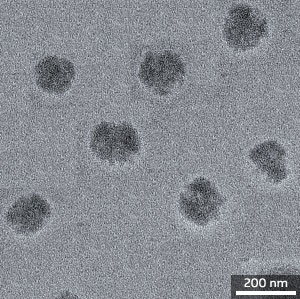| May 11, 2011 |
Nanomedicine: Loading up a cure
|
|
(Nanowerk News) Micelles—nanoparticles with a core–shell structure—are ideal vehicles for targeted drug delivery and have the potential to revolutionize the treatment of diseases such as cancer. They come in a wide range of sizes, but most have low loading capacity, meaning they can only carry a small amount of a drug, and dissociate rapidly in the bloodstream upon contact with proteins, which can prevent the drug from reaching the intended targets.
|
|
To address these shortcomings, a team led by Yiyan Yang from the A*STAR Institute of Bioengineering and Nanotechnology and James Hedrick from the IBM Almaden Research Center in the USA has now generated a polymer that self-assembles into micelles with high loading capacity and stability in the body ("Supramolecular nanostructures designed for high cargo loading capacity and kinetic stability").
|
|
"There are micelles that can transport large amounts of drugs, but their synthesis is usually tedious, expensive and gives low yields," says Yang. "We have now developed an approach to produce biodegradable and biocompatible polycarbonate copolymers that form uniformly sized micelles in high yields from inexpensive starting materials. Furthermore, the synthesis can be scaled up for future clinical applications."
|
 |
| Transmission electron microscopy image of doxorubin-loaded mixed micelles. (© 2011 Elsevier)
|
|
The researchers designed various copolymers composed of a polyethylene glycol subunit linked to a polycarbonate chain bearing acid or urea functional groups. These groups allowed the polymers to simultaneously bind to each other and to the chemotherapy drug doxorubin through strong intermolecular forces.
|
|
The team synthesized copolymers through the ring-opening polymerization of urea- and acid-functionalized cyclic carbonates in the presence of organic catalysts. When mixed in water, the copolymers associated into spherical micelles consisting of a polycarbonate core consolidated by hydrogen bonds and a polyethylene glycol shell. The anticancer drug, which contains a weakly basic amino functional group, attached to the core through acid–base ionic interactions.
|
|
"As the drug is carried in the core, it is protected from degradation when travelling in the blood stream," explains Yang. "It will not harm healthy cells before it reaches and penetrates through leaky tumor tissues." The shell also stopped unwanted drug seepage and protein adhesion.
|
|
When the team tested the potential of the micelles for drug delivery in vitro, they observed that the micelles steadily released doxorubin to cancer cells, and killed the cancer cells efficiently. The micelles can encapsulate and deliver amine-, carbonyl- and sulfate-bearing drugs by forming non-covalent interactions with acid or urea groups located in the core.
|
|
The researchers are currently conducting animal studies to evaluate the toxicity, biodistribution and efficacy of the micelles. "We are seeking industrial and clinical collaborators to advance towards clinical applications," says Yang.
|

